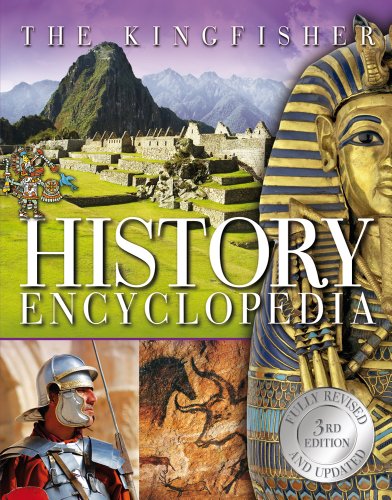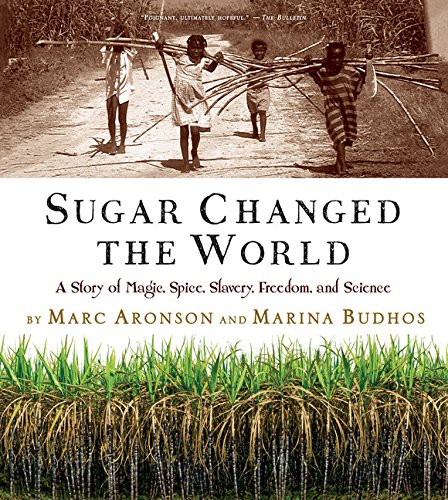On this page: General Resources | World History Through a Lens | World Cultures | Teaching Tips
world history pages
General resources
📖 The Kingfisher History Encyclopedia. This comprehensive reference book is worth having on hand as you make your way through World History: "From man's earliest history right through to the technological and social revolutions of the current day, this trusted reference provides a one-stop source for research, and is the perfect companion to any study of world history. The encyclopedia is organized chronologically and then thematically within each time period. A timeline runs across the top of each page for context." – All
📖 Maps by Aleksandra and Daniel Mizielinska. Geography buffs will definitely want to own a copy of this visually stunning oversized treasury of maps: “It features not only borders, cities, rivers, and peaks, but also places of historical and cultural interest, eminent personalities, iconic animals and plants, cultural events, and many more fascinating facts associated with every region of our planet.” – All
📖 The Story of the World series by Susan Wise Bauer. Susan Wise Bauer is the author of The Well-Trained Mind, the definitive tome on classical homeschooling, Her popular Story of the World series follows the classical four-year progression through Ancient History, The Middle Ages, Early Modern Times, and The Modern Age. These clearly written books are designed specifically for the grammar stage (elementary) child. The series is written from a Christian perspective, and biblical stories are interspersed throughout the book. – Elementary
📖 A Little History of the World by E. H. Gombrich. For a fantastic and accessible introduction to history, consider starting with this classic; note that the focus is on the trajectory of Western Civilization from ancient times to today. The linked image takes you to the recently revised illustrated edition of the book. – Elementary • Middle
📖 Horrible Histories by Terry Deary. The books in this British series are irreverent, heavily illustrated, and filled with gross-out humor. They are accurately billed as "history with the nasty bits left in." See the individual pages for book recommendations. – Elementary • Middle
▶️ Horrible Histories TV show. Episodes of the popular “Horrible Histories” sketch show are available to stream on Amazon, Hulu, and YouTube. Search the Horrible Histories Sketch List to find every sketch organized by topic, episode, and time-stamp.. – Elementary • Middle
📖 Human Odyssey by K12. The Human Odyssey textbook series is a fine choice for a Middle School World History spine. Volume 1 covers Prehistory through the Middle Ages, Volume 2 discusses the period from 1400-1914, and Volume 3 spans 1914 to the the turn of this century. See the time period home pages for more on each volume. – Middle
📖 Cartoon History series by Larry Gonick. For a more humorous overview of World History, check out Gonick’s popular Cartoon Histories. The three volumes of the Cartoon History of the Universe series cover the Big Bang to the Renaissance. The two volumes of the Cartoon History of the Modern World series span Early Modern to Modern History. See the time period home pages for more on each volume. The format is entertaining, but the content goes into some depth, and the illustrations and text are PG-rated; best for older students. – Middle • High
▶️ World History 1 and World History 2 from Crash Course. These two Crash Course video series give an excellent, humorous overview of World History at a level that’s just right for middle and high school students (note that the language can be a little salty). Each episode is 10-15 minutes in length; check the individual topic pages for relevant videos or browse the entire playlists by clicking on the three horizontal bars at the top of each video block below. – Middle • High
world history THrough A Lens
Each of these resources examines World History through the lens of a specific topic, such as money, chocolate, or counting. These books and videos can serve as a good starting point for a multidisciplinary unit study.
📖 The Story of Clocks and Calendars by Betsy & Giulio Maestro. The Maestros tell the story of how we measure time in this thorough, beautifully illustrated book. Read about how ancient cultures organized their calendars, how today's Gregorian calendar was refined, and how ancient and modern clocks allow us to measure the passage of time. Two good alternatives are: How Do You Know What Time It Is? by Robert Wells and About Time: A First Look at Time and Clocks by Bruce Koscielniak. – Elementary • Middle
📖 The History of Counting by Denise Schmandt-Besserat. This fascinating picture book answers a question that many of us have never considered: How was counting invented? The book focuses on the development of the base ten numbering system that we use today, and works well with a study of place value in arithmetic. Recommended for slightly older kids—the text is simple but the concepts are complex. – Elementary • Middle
📖 The History of Money: From Bartering to Banking by Martin Jenkins. Written in an engaging, conversational tone, Jenkins’ short chapter book explains how currency has evolved as a result of the transition from nomadic to agricultural to industrial society. Alternatively, see The Story of Money by Betsy Maestro, written for a slightly younger audience. Spanning prehistory to the modern age, Maestro's picture book describes the evolution of money from the first Sumerian coins to the opening of the Philadelphia mint and beyond. – Elementary • Middle
📖 The Story of Salt by Mark Kurlansky. Table salt has played a surprising role in shaping the course of history. As Kurlansky puts it, “[T]hat simple common thing—salt—has been the object of wars and revolutions.” Adapted from Kurlansky’s adult bestseller, this picture book is a fascinating salt-sprinkled romp through World History. – Elementary • Middle
📖 The Book of Chocolate: The Amazing Story of the World’s Favorite Candy by HP Newquist. If you want to pick a topic for an in-depth unit study, you can hardly beat chocolate. The Book of Chocolate is a terrific, in-depth chapter book account of the history and science of making chocolate. Chapter titles include The Mysterious History of Chocolate, Chocolate and the Second World War, and The Modern Makers. – Middle • High
📖 Sugar Changed the World: A Story of Magic, Spice, Slavery, Freedom, and Science by Marc Aronson & Marina Budhos. "With songs, oral histories, maps, and over 80 archival illustrations, here is the story of how one product allows us to see the grand currents of world history in new ways." Opening with Alexander the Great on the banks of the Indus River, this book traces the long history of sugar, from its earliest cultivation to its worldwide spread and its role in the Caribbean slave trade. – Middle • High
📖 1493 for Young People: From Columbus's Voyage to Globalization by Charles Mann. Rebecca Stefoff's new adaptation of Mann's adult bestseller examines world history through the wide 'lens' of globalization. This in-depth book takes on the Atlantic slave trade, Pacific voyages of exploration, and the plants, animals, and diseases that were transferred across the Atlantic through the Columbian exchange (tomatoes, potatoes, earthworms, malaria, and more). – Middle • High
🔗 Content Connection: US History. Find more ideas for interdisciplinary history studies in US History Through a Lens.
▶️ NEW • Who decides how long a second is? from TED-Ed. “In 1967, researchers gathered to answer a long-running scientific question: just how long is a second? It might seem obvious at first. A second is the tick of a clock, the swing of a pendulum, the time it takes to count to one. But how precise are those measurements? And what is that length based on?” Part history, part science. – Middle • High
▶️ History through the eyes of the potato from TED-Ed. "Potatoes have played a much more significant role in our history than just that of the dietary staple we have come to know and love today. Leo Bear-McGuinness shares how without the potato, our modern civilization might not exist at all." – All
▶️ A brief history of chess from TED-Ed. “The attacking infantry advances, their elephants already having broken the defensive line. The king tries to retreat, but the enemy flanks him from the rear. Escape is impossible. This isn’t a real war—nor is it just a game. Over the 1,500 years of its existence, chess has been known as a military strategy tool, a metaphor for human affairs and a measure of genius.” – All
▶️ The history of tea from TED-Ed. “Tea is the second most consumed beverage in the world after water––and from sugary Turkish Rize tea to salty Tibetan butter tea, there are almost as many ways of preparing the beverage as there are cultures on the globe. Where did this beverage originate, and how did it become so popular? Shunan Teng details tea’s long history.” – All
▶️ History through the eyes of a chicken from TED-Ed. “The Ancient Egyptian king Thutmose III described the chicken as a marvelous foreign bird that “gives birth daily.” Romans brought them on their military campaigns to foretell the success of future battles. Today, this bird occupies a much less honorable position—on dinner plates. Chris Kniesly explains the evolving role of chickens throughout history.” – All
▶️ A brie(f) history of cheese from TED-Ed. “Before empires and royalty, before pottery and writing, before metal tools and weapons—there was cheese. As early as 8000 BCE, Neolithic farmers began a legacy of cheesemaking almost as old as civilization. Today, the world produces roughly 22 billion kilograms of cheese a year, shipped and consumed around the globe. Paul Kindstedt shares the history of one of our oldest and most beloved foods.” – All
▶️ The history of the world according to cats from TED-Ed. “In ancient times, wildcats were fierce carnivorous hunters. And unlike dogs, who have undergone centuries of selective breeding, modern cats are genetically very similar to ancient cats. How did these solitary, fierce predators become our sofa sidekicks? Eva-Maria Geigl traces the domestication of the modern house cat.” – All
▶️ The history of chocolate from TED-Ed. “If you can’t imagine life without chocolate, you’re lucky you weren’t born before the 16th century. Until then, chocolate only existed as a bitter, foamy drink in Mesoamerica. So how did we get from a bitter beverage to the chocolate bars of today? Deanna Pucciarelli traces the fascinating and often cruel history of chocolate.” – All
World Cultures
📖 Around the World in a Bathtub: Bathing All over the Globe by Wade Bradford. Here’s an interesting take on World Cultures—how do kids bathe around the world? This funny little picture book, illustrated with cheerful collage art, takes a look at bathing customs in Turkey, Alaska, Japan, Nepal, and more. – Preschool • Elementary
📖 Birthdays Around the World by Margriet Ruurs. Meet seventeen children from around the world and learn the different ways that they celebrate their birthdays. Each child’s custom is described with spare text in a nicely-illustrated two-page spread. Countries include Vietnam, Ghana, Russia, and Peru. If you like this format, check out the other books in this series: Families Around the World, Children Around the World, and School Days Around the World. – Preschool • Elementary
📖 This is How We Do It: One Day in the Lives of Seven Kids from around the World by Matt Lamothe. Meet seven children—from Italy, Japan, Uganda, Russia, Peru, India, and Iran—as they describe their daily lives. See where they live, how they learn, how they play, and more. This is a lovely, accessible introduction to other cultures. If you love this book, also check out This Is How I Do It, an activity book that introduces more cultures and invites kids to document their own lives. – Elementary
📖 If You Lived Here: Houses of the World by Giles Laroche. Learn about many different types of dwellings around the world in this beautiful book. Each two-page spread begins with a brief narrative (“If you lived here …”) and includes information on building materials, location, and fascinating facts. The real draw is Laroche’s appealing collage artwork, which decorates every page. – Preschool • Elementary
📖 Wonderful Houses Around the World by Yoshio Komatsu. With photographs accompanied by detailed cross-section illustrations, Komatsu shows the very different ways that people live around the world. The book shows distinctive homes in ten countries, including Mongolia, Senegal, Indonesia, and Bolivia. – Preschool • Elementary
📖 Hungry Planet: What the World Eats by Peter Menzel & Faith d'Aluisio. Here is a wonderful example of the power of photojournalism: "Hungry Planet profiles 30 families from around the world—including Bosnia, Chad, Egypt, Greenland, Japan, the United States, and France—and offers detailed descriptions of weekly food purchases; photographs of the families at home, at market, and in their communities; and a portrait of each family surrounded by a week's worth of groceries." Highly recommended. – All
📖 Material World: A Global Family Portrait by Peter Menzel, Charles C. Mann & Paul Kennedy. Material World is another visually stunning, eye-opening book from Menzel. "In an unprecedented effort, sixteen of the world’s foremost photographers traveled to thirty nations around the globe to live for a week with families that were statistically average for that nation. At the end of each visit, photographer and family collaborated on a remarkable portrait of the family members outside their home, surrounded by all of their possessions—a few jars and jugs for some, an explosion of electronic gadgetry for others." – All
teaching tips
The World History pages are organized into four time periods. The homepage for each time period links out to a collection of individual topic pages. Consult these homepages and the General Resources above to find recommended textbooks and other useful resources to help guide your World History studies.
Some topics in World History don’t neatly conform to the designated time periods. It is sometimes more logical to group resources by geography rather than by time period. For example, the Ancient Americas page includes cultures that flourished during Ancient times as well as during the European Middle Ages and the Early Modern Era. The “Connection” links across the World History pages will point you to these ‘chronologically misplaced’ resources.
Build unit studies. Follow cross-subject “Connection” links on the World History topic pages to build rich, multi-disciplinary unit studies. The resources in World History Through a Lens offer further opportunities to develop topic-based unit studies.
Don’t try to do everything. These pages are full of great resources. However, you don’t need to read every book, watch every video, and do every project. Sometimes it’s enough to read one picture book, watch a short video, and move on. Other times, your child will become absorbed in a topic, and you will want to slow down and explore more deeply. Let your child’s age and interests be your guide.
Don’t confine yourself to grade-level designations. The resources are broadly delineated by grade level (Preschool, Elementary, Middle, and High). However, if your Elementary School child discovers a passion for a certain subject, consult the Middle School resources for ideas on ways to extend your study. Likewise, if your Middle School child has never encountered a subject before, browse the Elementary School resources for ideas on how to cover the basics.




























